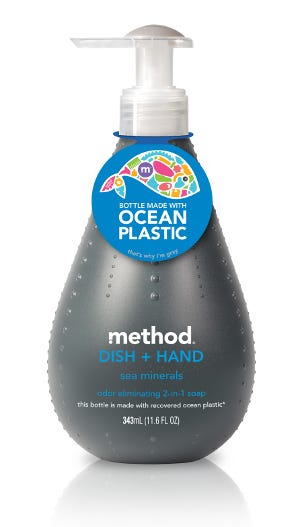Visionary: Method sees an ocean of opportunities

Rudi Becker
Rudi Becker, "the resinator" (aka director of packaging) at Method Products Inc., comes clean about recycled-content packaging and breaking through paradigms. Why settle when you can soar?
Q: What consumer trend(s) will have the most impact on how products are packaged in the future and why?
A: Consumers are becoming more informed about packaging materials and, more frequently, they are asking for recycled content in packaging. However, I believe there are still huge opportunities for the packaging industry to drive more environmentally responsible solutions for consumers.
I have always been a big proponent of the Cradle to Cradle philosophy. At Method, bottles are made from bottles. The use of 100-percent post-consumer recycled plastic in Method's bottles results in less energy consumed to make resin and fewer bottles ending up in landfills.
As packaging professionals, we need to be advocates for using the resources that already exist and drive solutions that address many of the challenges accompanying the use of post-consumer content. With greater-than-before demand from the consumer, and an industry that embraces sustainable solutions, there's no reason why the future of packaging should not be dominated by the use of recycled content.
Q: What are some of the most exciting packaging projects you've been involved with?
A: I recently helped develop a bottle made from recovered ocean plastic. It was one of the most exciting and rewarding projects I've worked on. People thought we were crazy at the onset of this idea: Let's take plastic that has been in the ocean, perhaps for years, and give it a new lease on life as a soap bottle. Through strong relationships with recyclers and suppliers, we were able to work through the logistics and technical issues associated with the project, making something that seemed impossible a reality.
By participating in several beach clean-ups, it gave me the opportunity to truly appreciate the scale of the problem first hand. It's estimated that several million tons of plastic makes its way into our oceans every year, polluting the environment and damaging marine life. I know that the Method Ocean Plastic project is not going to clean up the world's oceans, but a packaging project like this can raise awareness about an important issue and demonstrates a smart way of using plastic that is already on the planet.
Watch a two-minute video overview of the problem of ocean plastic and what we're doing at www.packagingdigest.com/MethodOcean.
Q: What advice do you have for the next generation of packaging professionals?
A: Don't be content with existing paradigms and don't settle for "No, we can't do that." I really do believe that you are only limited by your imagination. I can't tell you how many times I have been involved in a project and the initial reaction to an idea was overwhelmingly focused on how something can't be done. Innovation is not easy, and it takes commitment and drive to realize your vision. Take on risk, challenge your colleagues, push your supplier base out of their comfort zone and strive to do something that is truly original.
Packaging innovation spurs rapid growth

Ocean Plastic
Method took the high-design road from the start. Beautiful, artsy packages not only look good, but often do good for the environment.
2000—Method is born, the brainchild of co-founders Adam Lowry and Eric Ryan.
2001—The company's first eco-friendly cleaning sprays and dish soaps—made with non-toxic ingredients packaged in stylish containers (so cleaning products don't have to hide under the sink)—are test marketed in 90 Target stores. In seven short months, Target begins selling Method products nationwide.
2003—Method debuts its first hand wash in the brand's iconic teardrop-shaped bottle, which becomes one of the company's most popular products.
2004—The company launches the first triple-concentrated (3x) laundry detergent in the U.S. mass market.
2008—Method begins using bottles from 100 percent post-consumer recycled plastic.
Its liquid hand soap spouted refill pouches use 83 percent less plastic than a similar PET bottle and take less energy to produce.
2010—Method 8x concentrated laundry detergent debuts in a handheld pump bottle that eliminates the need for (and the mess of) dosage cups. The new closure allows for easy, accurate dispensing of detergent directly into the washing machine.

Method laundry detergent
2011—Method partners with upcycling/recycling pioneer TerraCycle to create the Method Refill Brigade. Consumers send their used soap refill pouches to TerraCycle. For each package received, TerraCycle and Method pay two cents to a charity of the collector's choice. The collected packaging is reused to make trash cans, coolers, plastic bags and other home goods.
Method collaborates with Disney Consumer Products to make hand-washing fun. A bold new bottle is modeled after the silhouette of two of Disney's most iconic characters: Mickey Mouse and Minnie Mouse.
Standout merchandising display and smooth pouring action give Method's new detergent refill pouches—which feature a rigid spine along one side—strong appeal with U.S. retailers and consumers.
2012—Method is acquired by Ecover and together become the world's largest green cleaning company.
Method unveils the world's first line of packaging made from recovered ocean plastic. Method's bottle is 100 percent post-consumer polyethylene, made from a blend of plastic recovered from the ocean and PCR. Method employees and volunteers hand-collected more than one ton of plastic from the beaches of Hawaii for the first run of this innovative material.
Method launches first dryer-activated fabric softener spray. The concentrated product is sprayed directly into the dryer onto wet clothes and uses the clothes as a vehicle to disperse the product while the dryer spins, eliminating the need for the traditional dryer sheet. Dryer sheets are often made out of polyethylene or polyester, and can't be composted or recycled after use. Method's fabric spray bottle is made from 100 percent post-consumer recycled PET and can be recycled.
.
About the Author(s)
You May Also Like




